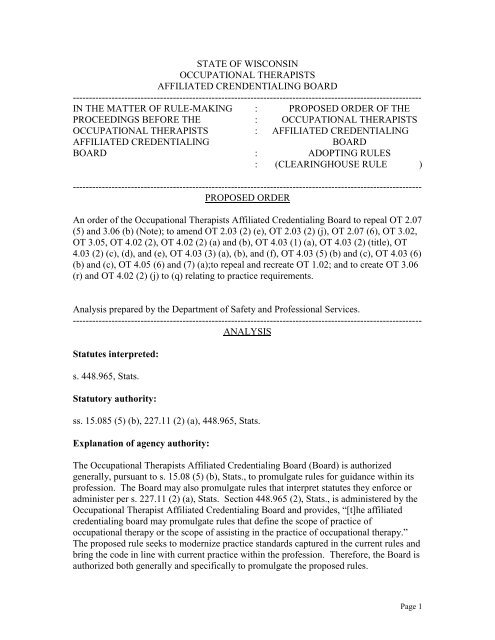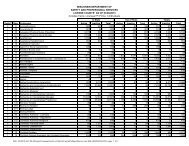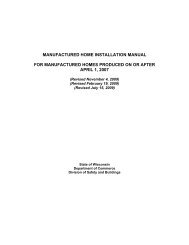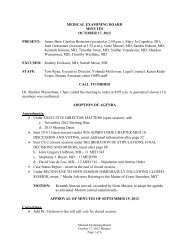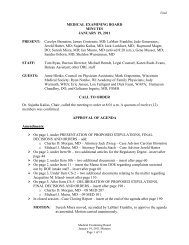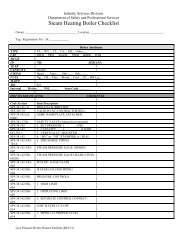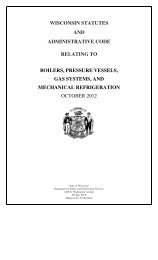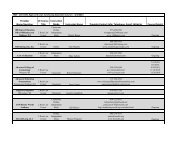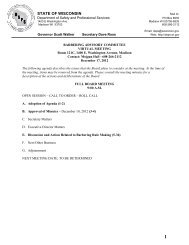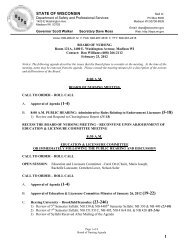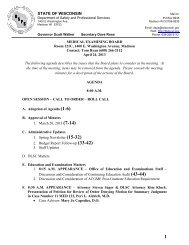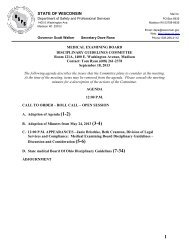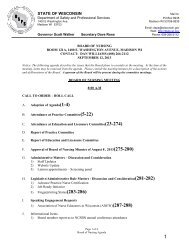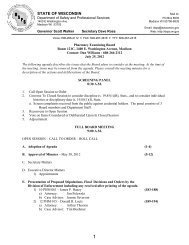OT 1, 2, 3, and 4: Practice Standards - Department Of Safety ...
OT 1, 2, 3, and 4: Practice Standards - Department Of Safety ...
OT 1, 2, 3, and 4: Practice Standards - Department Of Safety ...
Create successful ePaper yourself
Turn your PDF publications into a flip-book with our unique Google optimized e-Paper software.
STATE OF WISCONSINOCCUPATIONAL THERAPISTSAFFILIATED CRENDENTIALING BOARD------------------------------------------------------------------------------------------------------------IN THE MATTER OF RULE-MAKING : PROPOSED ORDER OF THEPROCEEDINGS BEFORE THE : OCCUPATIONAL THERAPISTSOCCUPATIONAL THERAPISTS : AFFILIATED CREDENTIALINGAFFILIATED CREDENTIALINGBOARDBOARD : ADOPTING RULES: (CLEARINGHOUSE RULE )------------------------------------------------------------------------------------------------------------PROPOSED ORDERAn order of the Occupational Therapists Affiliated Credentialing Board to repeal <strong>OT</strong> 2.07(5) <strong>and</strong> 3.06 (b) (Note); to amend <strong>OT</strong> 2.03 (2) (e), <strong>OT</strong> 2.03 (2) (j), <strong>OT</strong> 2.07 (6), <strong>OT</strong> 3.02,<strong>OT</strong> 3.05, <strong>OT</strong> 4.02 (2), <strong>OT</strong> 4.02 (2) (a) <strong>and</strong> (b), <strong>OT</strong> 4.03 (1) (a), <strong>OT</strong> 4.03 (2) (title), <strong>OT</strong>4.03 (2) (c), (d), <strong>and</strong> (e), <strong>OT</strong> 4.03 (3) (a), (b), <strong>and</strong> (f), <strong>OT</strong> 4.03 (5) (b) <strong>and</strong> (c), <strong>OT</strong> 4.03 (6)(b) <strong>and</strong> (c), <strong>OT</strong> 4.05 (6) <strong>and</strong> (7) (a);to repeal <strong>and</strong> recreate <strong>OT</strong> 1.02; <strong>and</strong> to create <strong>OT</strong> 3.06(r) <strong>and</strong> <strong>OT</strong> 4.02 (2) (j) to (q) relating to practice requirements.Analysis prepared by the <strong>Department</strong> of <strong>Safety</strong> <strong>and</strong> Professional Services.------------------------------------------------------------------------------------------------------------ANALYSISStatutes interpreted:s. 448.965, Stats.Statutory authority:ss. 15.085 (5) (b), 227.11 (2) (a), 448.965, Stats.Explanation of agency authority:The Occupational Therapists Affiliated Credentialing Board (Board) is authorizedgenerally, pursuant to s. 15.08 (5) (b), Stats., to promulgate rules for guidance within itsprofession. The Board may also promulgate rules that interpret statutes they enforce oradminister per s. 227.11 (2) (a), Stats. Section 448.965 (2), Stats., is administered by theOccupational Therapist Affiliated Credentialing Board <strong>and</strong> provides, “[t]he affiliatedcredentialing board may promulgate rules that define the scope of practice ofoccupational therapy or the scope of assisting in the practice of occupational therapy.”The proposed rule seeks to modernize practice st<strong>and</strong>ards captured in the current rules <strong>and</strong>bring the code in line with current practice within the profession. Therefore, the Board isauthorized both generally <strong>and</strong> specifically to promulgate the proposed rules.Page 1
Related statute or rule:Wis. Admin. Code chs. 1, 2, 3 <strong>and</strong> 4Plain language analysis:The Occupational Therapist Affiliated Credentialing Board reviewed its rules <strong>and</strong>determined that the rules were outdated. The Board identified several key areas in therules that were not typical of practice within the profession. The Board was alsoprompted by the American Occupational Therapy Association (A<strong>OT</strong>A). The A<strong>OT</strong>Achanged the definition of Occupational Therapy <strong>Practice</strong> for the A<strong>OT</strong>A Model <strong>Practice</strong>Act in April of 2011. The Board seeks to incorporate some of the language from theA<strong>OT</strong>A Model <strong>Practice</strong> Act within the proposed rules. Ultimately, the Board seeks toinstitute changes that will update the current code language with current practices withinthe profession.SECTION 1. recreated the definition provisions <strong>and</strong> defines areas of occupationoccupational performance skills, occupational performance contexts <strong>and</strong> environment aswell as other terms.SECTION 2. increases the time period from 3 to 5 years that an applicant may berequired to complete an oral examination, if they have not practiced prior to theirapplication.SECTION 3. amends <strong>OT</strong> 2.03 (2) (j) by omitting the term “been”.SECTION 4.repeals <strong>OT</strong> 2.07 (5).SECTION 5. amends language regarding expiration of temporary licensure.SECTION 6. amends the biennial renewal date from November 1 to June 1.SECTION 7. repeals the note found in the corresponding table.SECTION 8. creates a provision which was added to the table.SECTION 9. adds terms to the list of occupational therapy services.SECTION 10. creates additional provisions to the occupational therapy services listed ins. 4.02 (2) (j).SECTION 11. adds language to <strong>OT</strong> 4.03 (1) (a) specifying the objectives of occupationaltherapy.SECTION 12. amends the title in <strong>OT</strong> 4.03 (2) by striking the term “physician”.Page 2
SECTION 13. removes terms <strong>and</strong> clarifies the distinction between orders <strong>and</strong> referrals.SECTION 14. adds terms that distinguish between heath care provider <strong>and</strong> health careprofessional.SECTION 15. clarifies the terms related to program implementation.SECTION 16. amends the provision by adding terms that specify the support system thatshould be in place for discontinuation of services.SECTION 17. deletes unnecessary language.Summary of, <strong>and</strong> comparison with, existing or proposed federal regulation:None.Comparison with rules in adjacent states:Illinois: The Illinois Occupational Therapy <strong>Practice</strong> Act ILL. Admin. Code tit. 68§1315.100 governs <strong>OT</strong> practice in Illinois. The code sets forth provisions for modalitiesin occupational therapy, supervision of occupational therapy assistants <strong>and</strong> several othersections that the Wisconsin rules do not cover.Iowa: Iowa administrative code defines occupational therapy practice which includesphysical agent modalities 645 IAC 206.1, <strong>and</strong> sets forth a Code of Ethics foroccupational therapist 645 IAC 208.1, <strong>and</strong> grounds for discipline. 645 IAC 209. Othertopics covered include continuing education <strong>and</strong> supervision requirements.Michigan: In Michigan Occupational Therapists are governed under the Public HealthCode Act 368 of 1978 MCL <strong>and</strong> the <strong>Department</strong> of Consumer <strong>and</strong> Industry Services.Michigan statutes <strong>and</strong> administrative code do not set forth provisions regardingmodalities in occupational therapy or practice <strong>and</strong> supervision nor does it outline topicareas for the completion of continuing education credits as the current Wisconsin ruledoes.Minnesota: Minnesota statutes govern the scope of practice for Occupational Therapists.Minn. Stat. §§ 148.6401 -148.6450. The provisions cover such topics as physical agentmodalities <strong>and</strong> supervision of occupational therapy assistants similar to the currentWisconsin rules.Summary of factual data <strong>and</strong> analytical methodologies:The impetus for the proposed rule was a review by the Board which indicated that therewas a gap between terminology currently being used in the profession <strong>and</strong> the languagethat was in the rule. The Board decided to address this issue by drafting the proposedrule. No other factual data or analytical methodologies were used.Page 3
Analysis <strong>and</strong> supporting documents used to determine effect on small business or inpreparation of economic impact analysis:These proposed rules will not have an economic impact on small businesses, as definedin s. 227.114 (1), Stats.Fiscal Estimate <strong>and</strong> Economic Impact Analysis:The <strong>Department</strong> is currently soliciting information <strong>and</strong> advice from businesses, localgovernment units <strong>and</strong> individuals in order to prepare the Fiscal Estimate <strong>and</strong> theEconomic Impact Analysis.Effect on small business:These proposed rules will not have an economic impact on small businesses, as definedin s. 227.114 (1), Stats. The <strong>Department</strong>’s Regulatory Review Coordinator may becontacted by email at Greg.Gasper@wisconsin.gov, or by calling (608) 266-8608.Agency contact person:Shawn Leatherwood <strong>Department</strong> of <strong>Safety</strong> <strong>and</strong> Professional Services, Division of PolicyDevelopment, 1400 East Washington Avenue, Room 151, P.O. Box 8935, Madison,Wisconsin 53708; telephone 608 261-4438.Place where comments are to be submitted <strong>and</strong> deadline for submission:Comments may be submitted to Shawn Leatherwood <strong>Department</strong> of <strong>Safety</strong> <strong>and</strong>Professional Services, Division of Policy Development, 1400 East Washington Avenue,Room 151, P.O. Box 8935, Madison, WI 53708-8935, or by email toShancethea.Leatherwood@wisconsin.gov. Comments must be received on or before * tobe included in the record of rule-making proceedings.------------------------------------------------------------------------------------------------------------TEXT OF RULESECTION 1. <strong>OT</strong> 1.02 is repealed <strong>and</strong> recreated to read:<strong>OT</strong> 1.02 (1) “Activity dem<strong>and</strong>s” means the specific features of an activity that influencethe type <strong>and</strong> amount of the effort required to perform the activity. Activity dem<strong>and</strong>sinclude the specific objects, space dem<strong>and</strong>s, social dem<strong>and</strong>s, sequence <strong>and</strong> timing,required actions <strong>and</strong> performance of skills body functions <strong>and</strong> body structures.(2) “Areas of occupation” means the functional abilities that occupational therapyaddresses in the areas of activities of daily living such as instrumental activities of dailyPage 4
living , rest <strong>and</strong> sleep, educational activities , work <strong>and</strong> vocational activities, play leisure<strong>and</strong> social participation.(3) “Assessment” is a component part of the evaluation process, <strong>and</strong> means the process ofdetermining the need for, nature of, <strong>and</strong> estimated time of treatment at different intervalsduring the treatment, determining needed coordination with or referrals to otherdisciplines, <strong>and</strong> documenting these activities.(4) “Board” means the occupational therapists affiliated credentialing board.(5) “Body functions” means the physiological functions of body systems , includingmental, sensory, pain, neuromusculoskeletal, movement, cardiovascular, hematological,immunological, respiratory, voice , speech, digestive, metabolic, endocrine,genitourinary, reproductive, lymphatic, integumentary <strong>and</strong> related structures.(6) “Body structures” means anatomical parts of the body, such as organs, limbs, <strong>and</strong>their components that support body functions.(7) “Client factors” means values, beliefs, <strong>and</strong> spirituality, body functions, <strong>and</strong> bodystructures that reside within the client <strong>and</strong> may affect performance in areas of occupation.(8) “Consultation” means a work−centered, problem−solving helping relationship inwhich knowledge, experience, abilities <strong>and</strong> skills are shared with client, family,caregivers, <strong>and</strong> other professionals, including physicians, in the process of helping tohabilitate or rehabilitate through the use of occupational therapy.(9) “Entry−level” means the person has no demonstrated experience in a specificposition, such as a new graduate, a person new to the position, or a person in a newsetting with no previous experience in that area of practice.(10) “Evaluation” means the process of obtaining <strong>and</strong> interpreting data necessary forunderst<strong>and</strong>ing the individual system or situation. This includes planning for <strong>and</strong>documenting the evaluation process, results <strong>and</strong> recommendations, including the need forintervention <strong>and</strong> potential change in the intervention plan.(11) “Experienced” means demonstrated competence in the performance of duties in agiven area of practice.(12) “Habilitation” means an occupational therapy intervention designed for theeducation, training or support services provided to individuals to assist them in acquiring<strong>and</strong> maintaining skills not yet gained or learned, thus enabling them to learn, practice <strong>and</strong>refine skills needed for independent living, productive employment activity <strong>and</strong>community participation.Page 5
(13) “Level I fieldwork” means an integral part of didactic courses <strong>and</strong> includes variedlearning experiences. Students are supervised in observation <strong>and</strong> assistance with clientsduring short term contacts.(14) “Level II fieldwork” means extended fieldwork which emphasizes the application<strong>and</strong> integration of academically acquired knowledge <strong>and</strong> skills in the supervised deliveryof occupational therapy services to clients.(15) “Occupational performance skills” means the skills <strong>and</strong> abilities that an individualdemonstrates in the actions they perform including sensorimotor, sensory- perceptual,emotional regulation, cognition, communication, <strong>and</strong> social skills.(16) “Occupational performance contexts <strong>and</strong> environments” means a variety ofinterrelated conditions within <strong>and</strong> surrounding the client that influence an individual’sengagement in desired or required occupational performance including personal (age,gender, education; cultural, (customs, beliefs, behaviors); temporal (maturation, time ofday or year, duration, stage of disability); physical (natural <strong>and</strong> built environments);virtual (communication which occurs absent of physical contact via simulated, real timeor near time activity; social(relationships <strong>and</strong> expectations of persons groups <strong>and</strong>systems.(17) “Occupational therapist educational program” means an educational program <strong>and</strong>supervised internships in occupational therapy recognized by the board <strong>and</strong> accredited bythe Accreditation Council for Occupational Therapy Education or a program approved bythe World Federation of Occupational Therapy.(18) “Occupational therapy assistant educational program” means an educationalprogram <strong>and</strong> supervised internships in occupational therapy recognized by the board <strong>and</strong>accredited by the Accreditation Council for Occupational Therapy Education or aprogram approved by the World Federation of Occupational Therapy.(19) “Order” means the practice of identifying the need for occupational therapyeducation <strong>and</strong> intervention <strong>and</strong> delegating the responsibility to perform the evaluation<strong>and</strong> intervention to an occupational therapist.(20)”Performance patterns” means patterns of behavior related to an individual’s dailylife activities that are habitual or routine.(21) “Prevention” means the fostering of normal development, promoting health <strong>and</strong>wellness sustaining <strong>and</strong> protecting existing functions <strong>and</strong> abilities, preventing disabilityor supporting levels of restoration or change to enable individuals to maintain maximumindependence.(22) “Referral” means the practice of requesting occupational therapy services.(23) “Rehabilitation” means the process of treatment <strong>and</strong> education to restore a person’sability to live <strong>and</strong> work as normally as possible after a disabling injury or illness.Page 6
(24) “Screening” means the review of occupational performance skills in naturalenvironments, educational or clinical settings to determine the significance ofdiscrepancy between current performance <strong>and</strong> expected level of performance, which maybe done in consultation with a physician.(25) “Service competence” means the determination made by various methods that 2people performing the same or equivalent procedures will obtain the same or equivalentresults.(26) “Supervision” is a cooperative process in which 2 or more people participate in ajoint effort to establish, maintain <strong>and</strong> elevate a level of competence <strong>and</strong> performance.One of the participants, the supervisor, possesses skill, competence, experience,education, credentials, or authority in excess of those possessed by the other participant,the supervisee.SECTION 2. <strong>OT</strong> 2.03 (2) (e) is amended to read:<strong>OT</strong> 2.03 (2) (e) Has not practiced occupational therapy for a period of 3 5 years prior toapplication, unless the applicant has graduated from a school of occupational therapywithin that period. <strong>Practice</strong> for the purposes of this paragraph includes direct clienttreatment <strong>and</strong> education, occupational therapy instruction in an occupational therapyacademic program recognized by the board, occupational therapy research, <strong>and</strong> service inadministrative positions for health care providers or governmental bodies withresponsibility relating to occupational therapy.SECTION 3. <strong>OT</strong> 2.03 (2) (j) is amended to read:<strong>OT</strong> 2.03 (2) (j) Has been graduated from an occupational therapy school not approved bythe board.SECTION 4. <strong>OT</strong> 2.07 (5) is repealed.SECTION 5. <strong>OT</strong> 2.07 (6) is amended to read:<strong>OT</strong> 2.07 (6) A temporary license shall remain in effect for 6 months <strong>and</strong> may not berenewed.SECTION 6. <strong>OT</strong> 3.02 <strong>and</strong> 3.05 are amended to read:<strong>OT</strong> 3.02 Registration required; method of registration. Each licensee shall registerbiennially with the board. Prior to November 1 June 1 of each odd numbered year thedepartment shall mail to each licensee at his or her last known address as it appears in therecords of the board an application form for registration. Each licensee shall complete theapplication form <strong>and</strong> return it with the required fee to the department. The board shallnotify the licensee within 30 business days of receipt of a completed registration formwhether the application for registration is approved or denied.Page 7
<strong>OT</strong> 3.05 Failure to be registered. Failure to renew a license by November 1 June 1 ofodd numbered years shall cause the license to lapse. A licensee who allows the license tolapse may apply to the board for reinstatement of the license as follows:SECTION 7. <strong>OT</strong> 3.06 (b) Table (Note) is repealed.SECTION 8. <strong>OT</strong> 3.06 (r) Table is created to read:Professional Development Activities(r) Reimbursement or Ethics CoursesProfessional Development Points1 point per contact hourSECTION 9. <strong>OT</strong> 4.02 (2) (a) <strong>and</strong> (b) are amended to read:<strong>OT</strong> 4.02 (2) Occupational therapy services interventions include, but are not limited tothe following:<strong>OT</strong> 4.02 (2) (a) Screening, evaluating, developing, improving, sustaining or restoringskills in activities of daily living, work or productive activities, including instrumentalactivities of daily living, <strong>and</strong> play, <strong>and</strong> leisure activities, <strong>and</strong> rest <strong>and</strong> sleep education <strong>and</strong>social participation.<strong>OT</strong> 4.02 (2) (b) Evaluating, developing, remediating, or restoring sensorimotor,neuromusculosckeletal, cognitive, or psychosocial components of performance skills.SECTION 10. <strong>OT</strong> 4.02 (2) (j) to (q) are created to read:<strong>OT</strong> 4.02 (2) (j) Therapeutic use of occupations, exercises, <strong>and</strong> activities.(k) Training in self-care, self-management, health management <strong>and</strong> maintenance, homemanagement, community work reintegration, <strong>and</strong> school activities <strong>and</strong> workperformance.(L) Therapeutic use of self, including one’s personality, insights, perceptions <strong>and</strong>judgments, as part of the therapeutic process.(m) Assessment, recommendation, <strong>and</strong> training in techniques to enhance functionalmobility, including management of wheelchair <strong>and</strong> other mobility devices.(n) Low vision rehabilitation(o) Driver rehabilitation <strong>and</strong> community mobility(p)Management of feeding, eating, <strong>and</strong> swallowing to enable eating <strong>and</strong> feedingperformance.Page 8
(q) Facilitating the occupational performance of groups, populations, or organizationsthrough the modification of environments <strong>and</strong> adaptation processes.SECTION 11. <strong>OT</strong> 4.03 (1) (a) is amended to read:<strong>OT</strong> 4.03 (1) (a) An occupational therapist, alone or in collaboration with an occupationaltherapy assistant, when practicing either independently or as a member of a treatmentteam, shall identify individuals who present deficits or declines in areas of occupationoccupational performance areas skills <strong>and</strong> performance components patterns.SECTION 12. <strong>OT</strong> 4.03 (2) (title) is amended to read:<strong>OT</strong> 4.03 (2) REFERRAL AND PHYSICIAN ORDERS. (a) Evaluation, rehabilitation treatment,<strong>and</strong> implementation of treatment with individuals with specific medical conditions shallbe based on an order from a physician, dentist or podiatrist, or any other qualified healthcare professional.SECTION 13. <strong>OT</strong> 4.03 (2) (c), (d), <strong>and</strong> (e) are amended to read:<strong>OT</strong> 4.03 (2) (c) Although a referral an order is not required, an occupational therapist oroccupational therapy assistant may accept a referral for the purpose of providing serviceswhich include consultation, habilitation, screening, client education, wellness, prevention,environmental assessments, <strong>and</strong> work-related ergonomic services.<strong>OT</strong> 4.03 (2) (d) Physician orders Orders shall be in writing. However, oral referralsorders may be accepted if they are followed by a written <strong>and</strong> signed order by the referringphysician ordering professional within 72 hours from the date on which the clientconsults with the occupational therapist or occupational therapy assistant.<strong>OT</strong> 4.03 (2) (e) Physician order Orders or referral from another health care providerprofessional is not required for evaluation or intervention if an occupational therapist oroccupational therapy assistant provides services in an educational environment, includingthe child's home, for children <strong>and</strong> youth with disabilities pursuant to rules promulgatedby the federal individuals with disabilities education act, the department of publicinstruction <strong>and</strong> the department of health services, or provides services in an educationalenvironment for children <strong>and</strong> youth with disabilities pursuant to the code of federalregulations.SECTION 14. <strong>OT</strong> 4.03 (3) (a), (b), <strong>and</strong> (f) are amended to read:<strong>OT</strong> 4.03 (3) (a) The occupational therapist directs the evaluation process upon receivinga physician an order or referral from another health care provider professional. Anoccupational therapist alone or in collaboration with the occupational therapy assistantshall prepare an occupational therapy evaluation for each individual referred ordered forPage 9
occupational therapy services. The occupational therapist interprets the informationgathered in the evaluation process.<strong>OT</strong> 4.03 (3) (b) The evaluation shall consider the individual's medical, vocational, social,educational, family status, <strong>and</strong> personal <strong>and</strong> family goals, <strong>and</strong> shall include an assessmentof how occupational performance components skills <strong>and</strong> occupational performancecontexts influence the individual's functional abilities <strong>and</strong> deficits in occupationalperformance areas of occupation, patterns, contexts <strong>and</strong> environments.<strong>OT</strong> 4.03 (3) (e) Evaluation results shall be communicated to the referral source orderingprofessional <strong>and</strong> to the appropriate persons in the facility <strong>and</strong> community.<strong>OT</strong>4.03 (4) (d) In developing the program, the occupational therapist alone or incollaboration with the occupational therapy assistant shall also collaborate, asappropriate, with the individual, family, other health care professionals <strong>and</strong> communityresources; shall select the media, methods, environment, <strong>and</strong> personnel needed toaccomplish the goals; <strong>and</strong> shall determine the frequency <strong>and</strong> duration of occupationaltherapy services interventions provided.SECTION 15. <strong>OT</strong> 4.03 (5) (b) <strong>and</strong> (c) are amended to read:<strong>OT</strong> 4.03 (5) (b) The individual's areas of occupations occupational performance areasskills <strong>and</strong> occupational performance components patterns shall be routinely <strong>and</strong>systematically evaluated <strong>and</strong> documented.<strong>OT</strong> 4.03 (5) (c) Program modifications shall be formulated <strong>and</strong> implemented consistentwith the changes in the individual's occupational performance areas skills, occupationalperformance components patterns <strong>and</strong> occupational performance contexts <strong>and</strong>environments.SECTION 16. <strong>OT</strong> 4.03 (6) (b) <strong>and</strong> (c) is amended to read:<strong>OT</strong> 4.03 (6) (b) A comparison of the initial <strong>and</strong> current state of functional abilities <strong>and</strong>deficits in areas of occupation, occupational performance areas skills <strong>and</strong> occupationalperformance components patterns shall be made <strong>and</strong> documented.<strong>OT</strong> 4.03 (6) (c) A discharge plan shall be prepared, consistent with the servicesinterventions provided, the individual's goals, <strong>and</strong> the expected prognosis. Considerationshall be given to the individual's occupational performance contexts <strong>and</strong> environmentsincluding appropriate community resources for referral, <strong>and</strong> environmental factors orbarriers that may need modification.SECTION 17. <strong>OT</strong> 4.05 (6) <strong>and</strong> (7) (a) is amended to read:Page 10
<strong>OT</strong> 4.05 (6) An occupational therapist or occupational therapy assistant may delegate tonon-licensed personnel duties or functions other than maintenance or restorative servicesto the clients, including but not limited to the following services:<strong>OT</strong> 4.05 (7) (a) Interpretation of referrals or prescriptions orders for occupational therapyservices.SECTION 18. The rules adopted in this order shall take effect on the first day of the monthfollowing publication in the Wisconsin administrative register, pursuant to s. 227.22 (2)(intro.), Stats.------------------------------------------------------------------------------------------------------------(END OF TEXT OF RULE)------------------------------------------------------------------------------------------------------------Dated _________________Agency __________________________________Member of the BoardOccupational Affiliated CredentialingBoardPage 11


